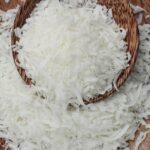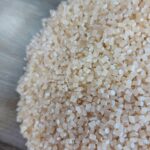CASHEW NUT SHELL OIL
Table of Contents
ToggleIn the food preservation industry, canned fish and meat are staples, known for their long shelf life and convenience. One key ingredient that enhances the quality and stability of these products is Distarch Phosphate (E1412). This modified starch plays a crucial role in ensuring the texture, consistency, and safety of canned goods. This blog post will delve into the benefits and process of using Distarch Phosphate (E1412) in producing canned fish and meat, providing a comprehensive guide for manufacturers.

What is Distarch Phosphate (E1412)?
Distarch Phosphate (E1412) is a modified starch produced by cross-linking starch with sodium trimetaphosphate or phosphorus oxychloride. This process enhances the starch’s stability, making it resistant to high temperatures, acidic conditions, and mechanical shear. E1412 is commonly used as a thickener, stabilizer, and emulsifier in various food products, including canned fish and meat.
Benefits of Using Distarch Phosphate (E1412) in Canned Fish and Meat
1. Enhanced Stability
E1412 provides exceptional stability to canned fish and meat, ensuring they maintain their texture and consistency during processing and storage. This stability is crucial for maintaining the quality of the product over time.
2. Improved Texture and Mouthfeel
The modified starch improves the texture and mouthfeel of canned products, giving them a more appealing and consistent quality. This is particularly important for consumer satisfaction and product differentiation in the market.
3. Thickening and Binding Properties
E1412 acts as an effective thickener and binder, helping to maintain the integrity of the product during high-temperature processing. This is essential for preventing separation and ensuring a uniform product.
4. Increased Shelf Life
By enhancing the stability and quality of canned fish and meat, E1412 helps extend their shelf life. This is beneficial for both manufacturers and consumers, ensuring products remain safe and enjoyable for longer periods.


The Production Process of Canned Fish and Meat with Distarch Phosphate (E1412)
1. Selection and Preparation of Raw Materials
Start by selecting high-quality fish or meat. Clean and prepare the raw materials by removing any unwanted parts, such as bones or skin, and cutting them into appropriate sizes.
2. Blanching
Blanch the fish or meat to kill bacteria and enzymes that could spoil the product. This process involves briefly boiling the raw materials and then cooling them rapidly to preserve their texture and color.
3. Preparation of the Canning Liquid
Prepare a canning liquid or brine solution, incorporating Distarch Phosphate (E1412). This solution acts as a medium for the fish or meat, enhancing its stability and texture during the canning process.
4. Filling the Cans
Place the blanched fish or meat into sterilized cans. Add the prepared canning liquid, ensuring that the product is fully submerged. The liquid should cover the fish or meat completely to prevent oxidation and spoilage.
5. Sealing the Cans
Seal the cans hermetically to create an airtight environment. This step is crucial for preventing contamination and ensuring the product remains sterile.
6. Thermal Processing
Subject the sealed cans to thermal processing, typically in a retort or pressure cooker. This process involves heating the cans to high temperatures to sterilize the contents and inactivate any remaining bacteria or enzymes. Distarch Phosphate (E1412) helps maintain the texture and consistency of the product during this high-heat treatment.
7. Cooling and Storage
After thermal processing, cool the cans rapidly to prevent overcooking. Store the canned fish or meat in a cool, dry place to ensure they remain stable and safe for consumption.
Ensuring Quality Control
Throughout the production process, maintain strict quality control measures to ensure the safety and quality of the canned fish and meat. Regularly test the product for microbial contamination, texture, and consistency to ensure it meets the required standards.
Conclusion
Distarch Phosphate (E1412) plays a pivotal role in the production of high-quality canned fish and meat. Its ability to enhance stability, texture, and shelf life makes it an indispensable ingredient in the canning industry. By incorporating E1412 into the production process, manufacturers can ensure their products meet consumer expectations for quality and safety.
For more insights and information on how Distarch Phosphate (E1412) can benefit your production process, visit Abimexco.












